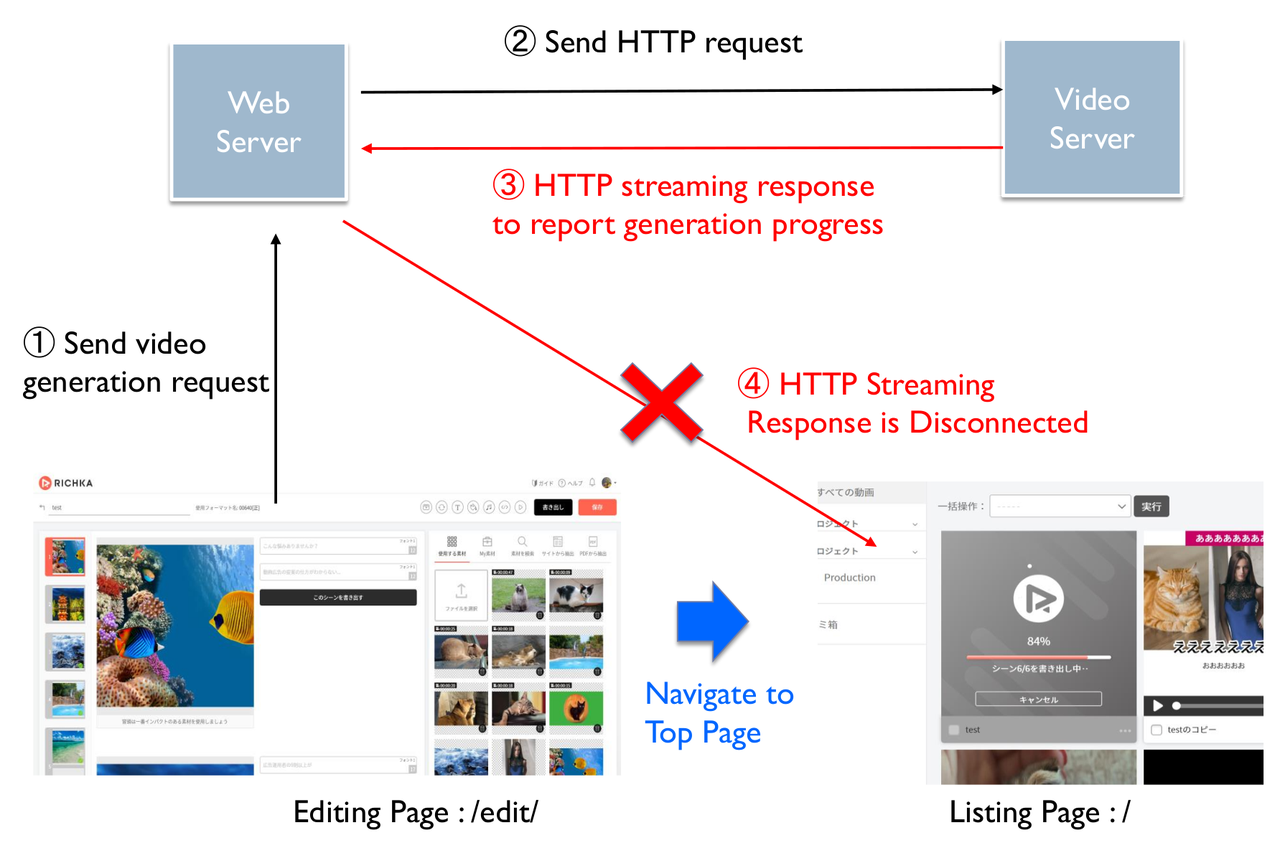Realtime Display of Video Generation Progress
Abstract
The video generation in RICHKA is to serialize high quality videos on video servers with using video templates designed by export designers. The processing is heavy load and takes several minutes, therefore RICHKA has a dedicated GUI feature to show the progress ratio in realtime so that users can check the remained waiting time. During the processing, video servers monitor the detail progresses and transmit to web servers to feedback to users on GUI.
RICHKA uses HTTP streaming for the realtime transmitting of the progress ratio among servers. This feature is to continue send application data little by little formatted with HTTP chunked encoding. During sending them, the TCP connection is kept to open. The HTTP streaming is available on general high-level web server frameworks as well and we are ready to apply to product services without taking care the underlying protocol format by ourselves. However, we need to understand the restriction that the HTTP connection is per URL. The restriction is simple, but we sometimes encounter difficulties on practical service products.
In the case of RICHKA, when users click a button to generate videos on editing pages, it redirects users to top page to see the progress ration on the video list so that users can edit other videos during generation videos. Then, the TCP connection between web browsers and web servers are disconnected in redirecting because of the restriction and the progress reporting from video servers don't reach to web browsers. To enable to show the realtime progress after HTTP redirecting, RICHKA has a dedicated server side processing and this post explains how RICHKA does. There are several alternatives to realize this feature, but RICHKA doesn't depend on additional external services and the internal architecture is also simple and straight forward. I think this architecture could be applied to general use cases and I hope this post provides some hints to readers of this blog.
Technical Restriction of HTTP streaming

The figure above represents the detail procedure how the progress reporting with the HTTP streaming is blocked. The bottom is the GUI of RICHKA and the left side is the editing page to input user data and the right side is the top page listing up users' videos. The blue arrow represents the HTTP redirect to navigate users to a top page and it is triggered when users click the button of video generation on the editing pages. In the timing, the HTTP streaming response from web servers are disconnected and the top page can't get the further progress ratio. The detail procedure in the figure is below.
- On edit pages, when users click a button to generate videos, it sends a HTTP request with XMLHttpRequest to one of web serves via load balancer. Then the browser is redirect to the top page listing video data.
- The Web server delegates the video generation to one of video servers with sending a HTTP request again. The video server loads a video template and start to generate a video
- During generating, the video server sends the progress ratio with HTTP chunked encoding whose application data is JSON format to the web server.
- The web server transfers the progress ratio received from the video server, but the TCP connection with the web browser has been already disconnected and the data can't reach it.
For a reference, the chunked transfer encoding is like this. In general, CGI scripts response with using it. Content-Length header is not used because the expected data size is not known beforehand. A chunked data starts with the payload size and it ends with a line break CR LF. In the final chunk, we need to send an empty chunked data to notify it is last one to the receiver. In RICHKA, the application data is the progress ratio formatted with JSON.
HTTP/1.1 200 OK
Content-Type: text/plain
Transfer-Encoding: chunked
5\r\n
Hello\r\n
6\r\n
RICHKA\r\n
0\r\n
\r\n
Realtime Display of Video Generation Progress after HTTP Redirect

To resolve this restriction deriving from the HTTP connection per URL, RICHKA realizes the realtime feedback of progress ratio with the architecture above for the specific case of redirecting. The detail procedure is below.
- ditto with the prior section
- The web server forks a dedicated process to communicate with the video server. It sends a HTTP request and delegates the video generation. In this timing, the TCP connection is disconnected with the web browser because of the redirection.
- The forked process is still alive and it continues to receive the progress ratio from video serves with HTTP chunked encoding.
- Every when the forked process receives the progress ratio, it saves into database as the progress data for the video data.
- After redirecting, the top page periodically sends HTTP GET request to the web server and show the progress data on GUI.
At the last step, there is alternative method with WebSocket protocol, but RICHKA doesn't use because general users access from their company offices and it is general their networks apply HTTP proxies. Unfortunately, some of HTTP proxies block WebSocket connection to enhance the web security. Therefore, RICHKA intentionally applies the traditional method to make more stable.